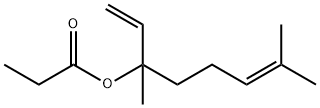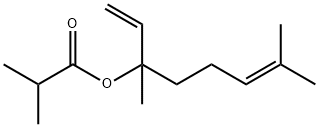PRODUCT Properties
| Boiling point: | 115 °C10 mm Hg(lit.) |
| Density | 0.895 g/mL at 25 °C(lit.) |
| vapor pressure | 5.5-9.8Pa at 20-25℃ |
| FEMA | 2645 | LINALYL PROPIONATE |
| refractive index | n |
| Flash point: | 207 °F |
| solubility | Very slightly soluble in water, soluble in alcohol and oils. Slightly soluble in Propylene glycol, insoluble in Glycerin. |
| form | clear liquid |
| color | Colorless to Almost colorless |
| Specific Gravity | 0.90 |
| Odor | at 100.00 %. fresh bergamot lily woody rose rum |
| Odor Type | floral |
| biological source | synthetic |
| JECFA Number | 360 |
| LogP | 4.9 at 35℃ and pH7 |
| CAS DataBase Reference | 144-39-8 |
| NIST Chemistry Reference | 1,6-Octadien-3-ol, 3,7-dimethyl-, propanoate(144-39-8) |
| EPA Substance Registry System | 1,6-Octadien-3-ol, 3,7-dimethyl-, propanoate (144-39-8) |
Description and Uses
Linalyl propionate has a sweet, floral odor reminiscent of bergamot oil and a sweet taste reminiscent of black currant (also pear and pineapple). May be synthesized by esterification of linalool with propionic acid or propionic anhydride.
Linalyl propionate is widely used in perfume compositions, not only as a support to Bergamot-notes, but in general as a sweet fresh additive in Citrus fragrances, light florals, herbaceous types or Ambre bases. It blends excellently with Clary Sage and Bergamot for Fougere opnotes, and introduces soft sweet notes as background for the middle notes of Muguet, Lilac, Freesia and many other floral types. The ester finds use in flavor compositions, partly as a sweetener, partly as fruity back-ground in imitation Banana, Blackcurrant, Redcurrant, Orange, Pear, Pineapple, and in “Tutti-frutti” etc. Concentration is normally about 3 to 12 ppm in the finished product.
Safety
| Symbol(GHS) |  GHS07 |
| Signal word | Warning |
| Hazard statements | H315-H319-H335 |
| Precautionary statements | P261-P264-P271-P280-P302+P352-P305+P351+P338 |
| Hazard Codes | Xi |
| Risk Statements | 36/37/38 |
| Safety Statements | 26-36 |
| WGK Germany | 2 |
| RTECS | RG5927903 |
| HS Code | 2915.50.5000 |
| Toxicity | Both the acute oral LD50 in rats and the acute dermal LD50 in rabbits exceeded 5 g/kg (Moreno, 1973). |





